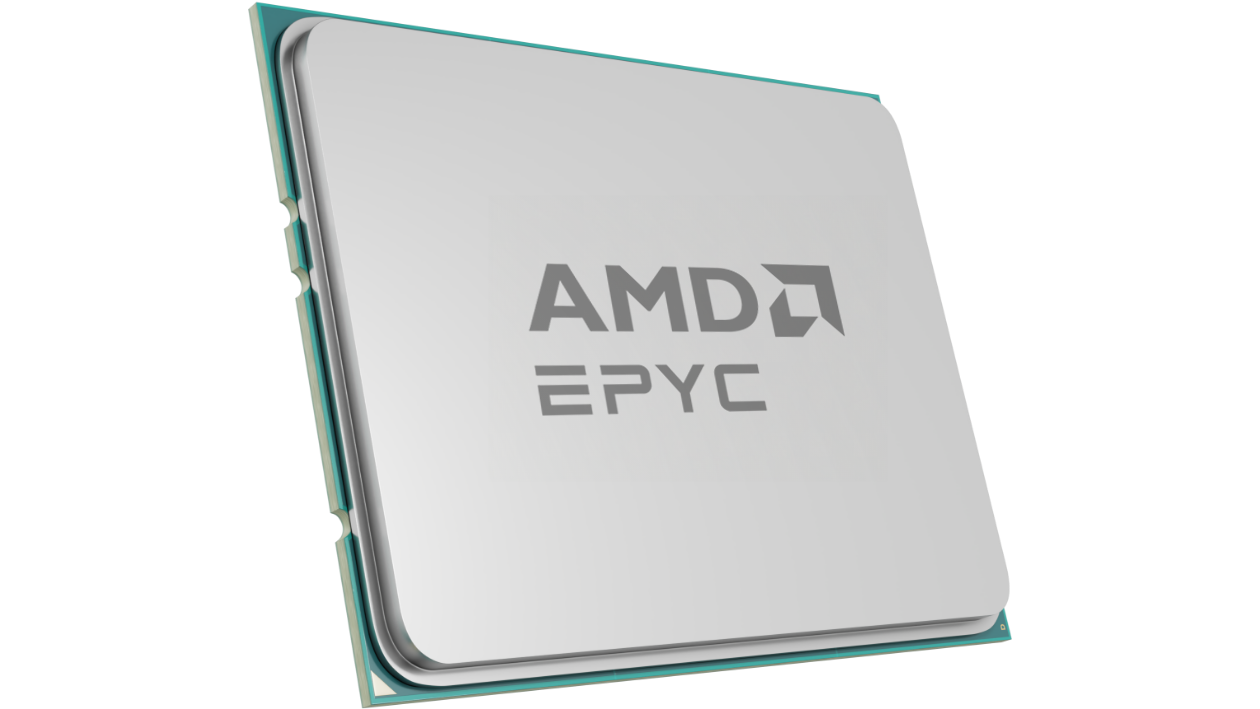4th Gen AMD EPYC™ Processors – Architectures Optimized for Enterprise Workloads
Nov 20, 2023

Historically, x86 processor design has focused on pushing the boundaries of performance. Innovative processor design is critical to driving improvement for users while improving efficiency. That is why the 4th Gen AMD EPYC™ processor family includes four unique processor designs for different workloads and deployments. Each processor leverages the benefits of ‘Zen 4’ or ‘Zen 4c’ cores.
Compared to the prior generation AMD EPYC 7763, the ‘Zen 4’ cores in the AMD EPYC 9534 delivers an estimated 45% more integer and 75% more floating point performance, which frees thermal envelopes to deliver more computing power.1,2
Meanwhile, ‘Zen 4c’ cores are optimized for density and efficiency. The physical layout takes less space, allowing up to 128 cores on a single processor, and is designed to deliver more performance per watt. This makes ‘Zen 4c’ ideal for cloud and edge deployments that value core density, small physical footprints, and energy efficiency.
These include:
- AMD EPYC 9004 processors for general-purpose computing, formerly codenamed “Genoa.”
- AMD EPYC 9004 processors with 3D V-Cache™ Technology for technical computing, formerly codenamed “Genoa-X.”
- AMD EPYC 97x4 processors for cloud-native workloads, formerly codenamed “Bergamo.”
- AMD EPYC 8004 processors for the intelligent edge, formerly codenamed “Siena.”
AMD EPYC 9004 Processors
The flagship CPU of the 4th Gen AMD EPYC™ family is the 9004 processor, the ideal CPU for general-purpose computing and AI Inference workloads. These EPYC™ processors feature leadership performance and are optimized for a wide range of workloads spanning from the enterprise to the cloud.
Customers who choose AMD EPYC 9654 processors can see a nearly 70% increase in server-side Java® operation throughput compared to Intel Xeon Platinum 8490H processors, helping them maintain SLAs and enable new workloads.3 This performance gives organizations the option to utilize fewer servers for the same amount of work – which can reduce cost, lower energy usage, and use less physical space.
Here is a scenario of an organization running 2000 VMs for its business applications. With servers powered by 2P AMD EPYC 9654 processor-powered, its estimated it can:
- Deploy only 11 servers for the compute it needs – compared to the 17 2P Intel® Xeon™ Platinum 8490H processor-based servers required for 2000 VMs
- Use up to 35% less power annually
- Help reduce hardware CAPEX by up to 47% 4
The EPYC 9004 processor has seen widespread adoption. Major cloud computing providers have deployed 9004 processors for both internal workloads and customer-facing instances, with over 640 customer instances available today, and more expected by the end of the year. This is why leading cloud provider AWS and database leader Oracle Exadata have chosen EPYC.

AMD EPYC 97x4 Processors
The growth of cloud computing has profoundly impacted how businesses approach IT in every aspect of their organizations. As cloud-native applications, which are designed to maximize the benefits of cloud infrastructure, become more popular, it is important to understand the benefits and drawbacks of the underlying hardware.
Cloud-native workloads run best on processors optimized for throughput and can provide leadership in scalability, density, and energy efficiency. AMD EPYC™ 97x4 processors are designed with new “Zen4c” cores – a cloud-optimized version of the “Zen 4” architecture. These specialized cores are specifically designed for the density and power efficiency cloud-native applications require.
With up to 128 “Zen 4c” cores, AMD EPYC™ 9754 processors provide up to 2.84x more performance across a wide range of cloud-native workloads compared to the both Intel and Ampere’s top-of-stack processor.5 This is why Meta chose it for its next generation high volume general compute platform. In addition, a 2P 128-core EPYC™ 9754 powered server delivers 2x the energy efficiency of a 2P Intel® Xeon™ Platinum 8490H-powered server in SPECpower_ssj® 2008.6
AMD EPYC 9004 Processors with 3D V-Cache Technology
Engineering simulations and other technical workloads have always demanded peak processing performance. To solve this challenge, the 4th Gen EPYC family includes AMD EPYC 9004 processors with 3D V-Cache Technology.
This processor is designed specifically for technical computing workloads, featuring up to 96 “Zen 4” cores and more than 1GB L3 cache. AMD EPYC 9684X processors can deliver up to a 2.44x performance uplift compared to a single 2P Intel® Xeon® 8480+ system on average across Ansys® CFX® workloads.7 This increased performance allows companies to bring products to market faster, providing a competitive advantage.
Users that focus on memory intensive HPC workloads such as finite element analysis, big data analytics, or computational fluid dynamics can now access EPYC 9004 processors with 3D V-Cache through Microsoft Azure’s HX-series VMs, which leverage these processors and 400 gigabit networking for supercomputer-scale performance in the cloud. And its customers like STMicroelectronics, PETRONAS digital, and Honda Performance Development are all seeing improved results to their businesses using AMD EPYC™ processors.
AMD EPYC 8004 Processors
AMD EPYC 8004 series processors have recently launched and are purpose-built for cloud, intelligent edge, and telco deployments. These new processors extend EPYC to the intelligent edge with a smaller form-factor.
Designed for low-power and space-constrained environments, these efficiency-focused processors provide the performance and capabilities you expect in an EPYC processor in a power envelope as low as 70 watts. With up to 64 “Zen 4c” cores, EPYC 8534P processors provide excellent performance-per-watt, requiring 49% less power per server and providing 2.1x the Java operation throughput of Intel Xeon Platinum 8471N processors.8
EPYC™ 8004 processor-based systems are available now from Dell, Lenovo, and Supermicro. These systems are designed to take advantage of the 8004 processors’ strengths in data center, intelligent edge, and telco environments.
A Complete Family of Processors
AMD knows that each customer has a unique set of computing needs. That is why, with the recent release of the EPYC™ 8004 processors, the EPYC family of purpose-built CPUs reaches from the data center to the cloud, and to the edge. Whether you need a balanced, general-purpose system to modernize your core business processes, an extreme processing power for CFD or similar technical computing workloads, a high-throughput, cloud-native processor to improve core density or efficiency, or a highly efficient, single-socket processor for the intelligent edge, the 4th Gen AMD EPYC™ family of processors has the right solution for you.
Find out more about the EPYC family and how it can help advance your business here.
Resources
- SP5-003B SPECrate®2017_int_base comparison based on published scores from www.spec.org as of 03/31/2023. Comparison of published 2P AMD EPYC 9534 (1250 SPECrate®2017_int_base, 560 Total TDP W, 128 Total Cores, 2.232 Perf/W, http://spec.org/cpu2017/results/res2023q1/cpu2017-20230116-33519.html) is 1.45x the performance of published 2P AMD EPYC 7763 (861 SPECrate®2017_int_base, 560 Total TDP W, 128 Total Cores, 1.538 Perf/W, http://spec.org/cpu2017/results/res2021q4/cpu2017-20211121-30148.html) [at 1.45x the performance/W]. SPEC®, SPEC CPU®, and SPECrate® are registered trademarks of the Standard Performance Evaluation Corporation. See www.spec.org for more information.
- SP5-004B SPECrate®2017_fp_base comparison based on published scores from www.spec.org as of 03/31/2023. Comparison of published 2P AMD EPYC 9534 (1160 SPECrate®2017_fp_base, 560 Total TDP W, 128 Total Cores, $17606 Total CPU $, 2.071 Perf/W, http://spec.org/cpu2017/results/res2023q1/cpu2017-20230116-33521.html) is 1.75x the performance of published 2P AMD EPYC 7763 (663 SPECrate®2017_fp_base, 560 Total TDP W, 128 Total Cores, $15780 Total CPU $, 1.184 Perf/W, http://spec.org/cpu2017/results/res2021q4/cpu2017-20211121-30146.html) [at 1.75x the performance/W] [at 1.57x the performance/CPU$]. AMD 1Ku pricing and Intel ARK.intel.com specifications and pricing as of 3/31/23. SPEC®, SPEC CPU®, and SPECrate® are registered trademarks of the Standard Performance Evaluation Corporation. See www.spec.org for more information.
- SP5-104A: SPECjbb® 2015-MultiJVM Critical based on published scores from www.spec.org as of 3/31/2023. Configurations: 2P AMD EPYC 9654 (664,375 SPECjbb®2015 MultiJVM max-jOPS, 622,315 SPECjbb®2015 MultiJVM critical-jOPS, 192 Total Cores, https://www.spec.org/jbb2015/results/res2022q4/jbb2015-20221019-00860.html) is 1.69x the critical-jOPS performance of published 2P Intel Xeon Platinum 8490H (458,295 SPECjbb®2015 MultiJVM max-jOPS, 368,979 SPECjbb®2015 MultiJVM critical-jOPS, 120 Total Cores, http://www.spec.org/jbb2015/results/res2023q1/jbb2015-20230119-01007.html). 2P AMD EPYC 7763 (339,338 SPECjbb®2015 MultiJVM max-jOPS, 313,824 SPECjbb®2015 MultiJVM critical-jOPS, 128 total cores, https://www.spec.org/jbb2015/results/res2021q3/jbb2015-20210701-00688.html) shown at 0.85x the performance and 2P Intel Xeon Platinum 8380 (269,094 SPECjbb®2015 MultiJVM max-jOPS, 213,195 SPECjbb®2015 MultiJVM critical-jOPS, 80 total cores, https://spec.org/jbb2015/results/res2021q3/jbb2015-20210810-00701.html) shown at 0.58x the performance for reference. SPEC® and SPECjbb® are registered trademarks of the Standard Performance Evaluation Corporation. See www.spec.org for more information.
- SP5TCO-036A –As of 05/19/2023 based on AMD Internal analysis using the AMD EPYC™ Server Virtualization & Greenhouse Gas Emission TCO Estimation Tool - version 12.15 estimating the cost and quantity of 2P AMD 96 core EPYC™ 9654 powered server versus 2P Intel® Xeon® 60 core Platinum 8490H based server solutions required to deliver 2000 total virtual machines (VM), requiring 1 core and 8GB of memory per VM for a 3-year period. This includes VMware software license cost of $6,558.32 per socket + one additional software for every 32 CPU core increment in that socket.
Environmental impact estimates made leveraging this data, using the Country / Region specific electricity factors from the '2020 Grid Electricity Emissions Factors v1.4 – September 2020', and the United States Environmental Protection Agency 'Greenhouse Gas Equivalencies Calculator'.
This scenario contains many assumptions and estimates and, while based on AMD internal research and best approximations, should be considered an example for information purposes only, and not used as a basis for decision making over actual testing. For additional details, see https://www.amd.com/en/legal/claims/epyc-claims.html#q=SP5TCO-036A. - https://www.amd.com/content/dam/amd/en/documents/epyc-business-docs/performance-briefs/amd-epyc-9754-pb-cloud-native-workloads.pdf
- https://www.amd.com/system/files/documents/amd-epyc-9754-pb-spec-power.pdf
- https://www.amd.com/system/files/documents/amd-epyc-9004x-pb-ansys-cfx.pdf
- SP6-007 – Server-side Java® overall operations/watt (SPECpower_ssj®2008) claim based on 1P published results at spec.org as of 9/18/2023. 1P servers: EPYC 8534P (64-core, 200W TDP) scoring 27,342 overall ssj_ops/W, https://spec.org/power_ssj2008/results/res2023q3/power_ssj2008-20230830-01309.html, 52.5W active idle, 7,289,747 ssj_ops@100% target load @ 212W) vs. 1P Xeon Platinum 8471N (52-core, 300W TDP, https://spec.org/power_ssj2008/results/res2023q3/power_ssj2008-20230822-01294.html, 88.2W active idle, 6,749,219 ssj_ops@100% target load @ 419W) scoring 12,821 ssj_ops/W for 2.10x the SPECpower_ssj2008 overall ssj_ops/W. Assuming an 8kW rack deploying servers, 37 ea. EPYC 8534P vs. 19 ea. Xeon 8471N can fit within the power budget delivering 1.91x the total server-side Java throughput/rack. This scenario contains many assumptions and estimates and, while based on AMD internal research and best approximations, should be considered an example for information purposes only, and not used as a basis for decision making over actual testing. SPEC and SPECpower_ssj® are registered trademarks of the Standard Performance Evaluation Corporation.
